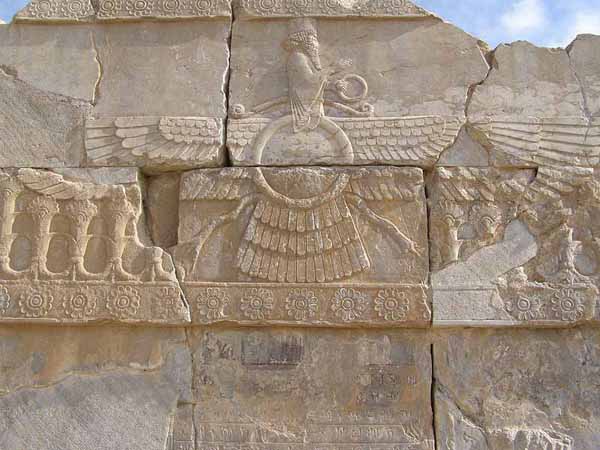
Achaemenid Empire
Zoroastrianism (or Mazdaism) is a religion and philosophy based on the teachings of prophet Zoroaster (also known as Zarathustra, in Avestan) and was formerly among the world's largest religions. It was probably founded some time before the 6th century BCE in Greater Iran.
In Zoroastrianism, the Creator Ahura Mazda is all good, and no evil originates from Him. Thus, in Zoroastrianism good and evil have distinct sources, with evil (druj) trying to destroy the creation of Mazda (asha), and good trying to sustain it. Mazda is not immanent in the world, and His creation is represented by the Amesha Spentas and the host of other Yazatas, through whom the works of God are evident to humanity, and through whom worship of Mazda is ultimately directed. The most important texts of the religion are those of the Avesta, of which a significant portion has been lost, and mostly only the liturgies of which have survived. The lost portions are known of only through references and brief quotations in the later works, primarily from the 9th to 11th centuries.
In some form, it served as the national or state religion of a significant portion of the Iranian people for many centuries. The religion first dwindled when the Achaemenid Empire was invaded by Alexander III of Macedon, after which it collapsed and disintegrated and it was further gradually marginalized by Islam from the 7th century onwards with the decline of the Sassanid Empire.
The political power of the pre-Islamic Iranian dynasties lent Zoroastrianism immense prestige in ancient times, and some of its leading doctrines were adopted by other religious systems. It has no major theological divisions (the only significant schism is based on calendar differences), but it is not uniform. Modern-era influences have a significant impact on individual and local beliefs, practices, values and vocabulary, sometimes complementing tradition and enriching it, but sometimes also displacing tradition entirely.
Zoroastrians believe that there is one universal and transcendent God, Ahura Mazda. He is said to be the one uncreated Creator to whom all worship is ultimately directed. Ahura Mazda's creation - evident as asha, truth and order - is the antithesis of chaos, which is evident as druj, falsehood and disorder. The resulting conflict involves the entire universe, including humanity, which has an active role to play in the conflict.
The religion states that active participation in life through good thoughts, good words, and good deeds is necessary to ensure happiness and to keep chaos at bay. This active participation is a central element in Zoroaster's concept of free will, and Zoroastrianism rejects all forms of monasticism. Ahura Mazda will ultimately prevail over the evil Angra Mainyu or Ahriman, at which point the universe will undergo a cosmic renovation and time will end. In the final renovation, all of creation - even the souls of the dead that were initially banished to "darkness" - will be reunited in Ahura Mazda, returning to life in the undead form. At the end of time, a savior-figure (a Saoshyant) will bring about a final renovation of the world (frasho.kereti), in which the dead will be revived.
In Zoroastrian tradition, the malevolent is represented by Angra Mainyu (also referred to as "Ahriman"), the "Destructive Principle", while the benevolent is represented through Ahura Mazda's Spenta Mainyu, the instrument or "Bounteous Principle" of the act of creation. It is through Spenta Mainyu that transcendental Ahura Mazda is immanent in humankind, and through which the Creator interacts with the world. According to Zoroastrian cosmology, in articulating the Ahuna Vairya formula, Ahura Mazda made His ultimate triumph evident to Angra Mainyu. As expressions and aspects of Creation, Ahura Mazda emanated the Amesha Spentas ("Bounteous Immortals"), that are each the hypostasis and representative of one aspect of that Creation. These Amesha Spenta are in turn assisted by a league of lesser principles, the Yazatas, each "Worthy of Worship" and each again a hypostasis of a moral or physical aspect of creation.
In Zoroastrianism, water (apo, aban) and fire (atar, adar) are agents of ritual purity, and the associated purification ceremonies are considered the basis of ritual life. In Zoroastrian cosmogony, water and fire are respectively the second and last primordial elements to have been created, and scripture considers fire to have its origin in the waters. Both water and fire are considered life-sustaining, and both water and fire are represented within the precinct of a fire temple. Zoroastrians usually pray in the presence of some form of fire (which can be considered evident in any source of light), and the culminating rite of the principle act of worship constitutes a "strengthening of the waters". Fire is considered a medium through which spiritual insight and wisdom is gained, and water is considered the source of that wisdom.
While the Parsees in India have traditionally been opposed to proselytizing, probably for historical reasons, and even considered it a crime for which the culprit may face expulsion, Iranian Zoroastrians have never been opposed to conversion, and the practice has been endorsed by the Council of Mobeds of Tehran. While the Iranian authorities do not permit proselytizing within Iran, Iranian Zoroastrians in exile have actively encouraged missionary activities, with The Zarathushtrian Assembly in Los Angeles and the International Zoroastrian Centre in Paris as two prominent centres.
As in many other faiths, Zoroastrians are strongly encouraged to marry others of the same faith, but this is not a requirement of the religion itself. Rather, it is a creation of those in India. Some members of the Indian Zoroastrian community (the Parsis) contend that a child must have a Parsi father to be eligible for introduction into the faith, but this assertion is considered by most to be a violation of the Zoroastrian tenets of gender equality, and may be a remnant of an old Indian legal definition (since overruled) of Parsi. This issue is a matter of debate within the Parsi community, but with the increasingly global nature of modern society and the dwindling number of Zoroastrians, such opinions are less vociferous than they were previously.
In Zoroastrian tradition, life is a temporary state in which a mortal is expected to actively participate in the continuing battle between truth and falsehood. Prior to being born, the soul (urvan) of an individual is still united with its fravashi, of which there are very many, and which have existed since Mazda created the universe. During life, the fravashi acts as a guardian and protector. On the fourth day after death, the soul is reunited with its fravashi, in which the experiences of life in the material world are collected for the continuing battle in the spiritual world. For the most part, Zoroastrianism does not have a notion of reincarnation, at least not until the final renovation of the world. Despite this, followers of Ilm-e-Kshnoom in India believe in reincarnation and practice vegetarianism, two principles unknown to Orthodox Zoroastrianism.
In Zoroastrian scripture and tradition, a corpse is a host for decay, i.e., of druj. Consequently, scripture enjoins the "safe" disposal of the dead in a manner such that a corpse does not pollute the "good" creation. These injunctions are the doctrinal basis of the fast-fading traditional practice of "ritual exposure", most commonly identified with the so-called "Towers of Silence" for which there is no standard technical term in either scripture or tradition. The practice of ritual exposure is only practiced by Zoroastrian communities of the Indian subcontinent, where it is not illegal, but where alternative disposal methods are desperately sought after diclofenac poisoning has led to the virtual extinction of scavenger birds. Other Zoroastrian communities either cremate their dead, or bury them in graves that are cased with lime mortar.

Achaemenid Empire
Although older, Zoroastrianism only enters recorded history in the mid-5th century BCE. Herodotus' The Histories (completed c. 440 BCE) includes a description of Greater Iranian society with what may be recognizably Zoroastrian features, including exposure of the dead.
The Histories is a primary source of information on the early period of the Achaemenid era (648–330 BCE), in particular with respect to the role of the Magi. According to Herodotus i.101, the Magi were the sixth tribe of the Medians (until the unification of the Persian empire under Cyrus the Great, all Iranians were referred to as "Mede" or "Mada" by the peoples of the Ancient World), who appear to have been the priestly caste of the Mesopotamian-influenced branch of Zoroastrianism today known as Zurvanism, and who wielded considerable influence at the courts of the Median emperors.
Following the unification of the Median and Persian empires in 550 BCE, Cyrus the Great and, later, his son Cambyses II curtailed the powers of the Magi after they had attempted to sow dissent following their loss of influence. In 522 BCE, the Magi revolted and set up a rival claimant to the throne. The usurper, pretending to be Cyrus' younger son Smerdis, took power shortly thereafter. Owing to the despotic rule of Cambyses and his long absence in Egypt, "the whole people, Persians, Medes and all the other nations" acknowledged the usurper, especially as he granted a remission of taxes for three years (Herodotus iii. 68).
According to the Behistun Inscription, pseudo-Smerdis ruled for seven months before being overthrown by Darius I in 521 BCE. The "Magi", though persecuted, continued to exist. A year following the death of the first pseudo-Smerdis (named Gaumata), a second pseudo-Smerdis (named Vahyazdāta) attempted a coup. The coup, though initially successful, failed.
Whether Cyrus II was a Zoroastrian is subject to debate. It did, however, influence him to the extent that it became the non-imposing religion of his empire, and its beliefs later allowed Cyrus to free the Jews and allow them to return to Judea when the emperor took Babylon in 539 BCE. Darius I was a devotee of Ahura Mazda, as attested to several times in the Behistun inscription. However, whether he was a follower of Zoroaster has not been conclusively established, since devotion to Ahura Mazda was (at the time) not necessarily an indication of an adherence to Zoroaster's teaching.
Darius I and later Achaemenid emperors, though acknowledging their devotion to Ahura Mazda in inscriptions, appear to have permitted religions to coexist. Nonetheless, it was during the Achaemenid period that Zoroastrianism gained momentum.
A number of the Zoroastrian texts that today are part of the greater compendium of the Avesta have been attributed to that period. It was also during the later Achaemenid era that many of the divinities and divine concepts of proto-Indo-Iranian religion(s) were incorporated in Zoroastrianism, in particular those to whom the days of the month of the Zoroastrian calendar are dedicated. This calendar is still used today, a fact that is attributed to the Achaemenid period. Additionally, the divinities, or yazatas, are present-day Zoroastrian angels (Dhalla, 1938).
Almost nothing is known of the status of Zoroastrianism under the Seleucids and Parthians, who ruled over Persia following Alexander the Great's invasion in 330 BCE. According to later Zoroastrian legend (Denkard and the Book of Arda Viraf), many sacred texts were lost when Alexander's troops invaded Persepolis and subsequently destroyed the royal library there. Diodorus Siculus's Bibliotheca historica, which was completed c. 60 BCE, appears to substantiate this Zoroastrian legend (Diod. 17.72.2–17.72.6).
According to one archaeological examination, the ruins of the palace of Xerxes bear traces of having been burned (Stolze, 1882). Whether a vast collection of (semi-)religious texts "written on parchment in gold ink", as suggested by the Denkard, actually existed remains a matter of speculation, but is unlikely. Given that many of the Denkards statements-as-fact have since been refuted among scholars, the tale of the library is widely accepted to be fictional (Kellens, 2002)
When the Sassanid Dynasty came into power in 228 CE, they aggressively promoted the Zurvanite form of Zoroastrianism and, in some cases, persecuted Christians. When the Sassanids captured territory, they often built fire temples there to promote their religion. After Constantine, the Sassanids were suspicious of Christians, not least because of their perceived ties to the Christian Roman Empire. As such the Persian Church (the Church of the East) officially broke with Roman Christianity, and was tolerated and even sometimes favored by the Sassanids.
A form of Zoroastrianism was also prominent in the pre-Christian Caucasus region (especially modern-day Azerbaijan). During the periods of their suzerainty over the Caucasus, the Sassanids made attempts to promote the religion there as well.
Well before the 6th century CE, Zoroastrianism had spread to northern China via the Silk Road, gaining official status in a number of Chinese states.[citation needed] Remains of Zoroastrian temples have been found in Kaifeng and Zhenjiang. By the 13th century, the religion had faded from prominence in China. However, Zoroastrianism (as well as later Manicheism) may still have influenced elements of Buddhism, especially in terms of light symbolism.
In the 7th century, and over the course of at least 16 years (several decades in the case of some provinces), the Sassanid Empire was overthrown by the Arabs. Although the administration of the state was rapidly Islamicized and subsumed under the Umayyad Caliphate, "there was little serious pressure" exerted on newly subjected people to adopt Islam. Islamic jurists considered only Muslims to be perfectly moral, and "unbelievers might as well be left to their inequities, so long as these did not vex their overlords."
There were also practical considerations: "because of their sheer numbers, the conquered Zoroastrians had to be treated as dhimmis (despite doubts [of the validity of this identification] that persisted down the centuries)," which made them eligible for protection. Thus, in the main, once the conquest was over and "local terms were agreed on", the Arab governors protected the local populations in exchange for tribute.
The Arabs adopted the Sassanid tax-system, both the land-tax levied on land owners and the poll-tax levied on individuals. This is called jizya, a tax levied on non-Muslims living in Muslim Caliphates (i.e., the dhimmis). In time, this poll-tax came to be used as a means to humble the non-Muslims, and a number of laws and restrictions evolved to emphasize their inferior status. Under the early orthodox caliphs, as long as the non-Muslims paid their taxes and adhered to the dhimmi laws, administrators were enjoined to leave non-Muslims "in their religion and their land." (Caliph Abu Bakr, qtd. in Boyce 1979, p. 146).
Thus, though subject to a new leadership and harassed, once the horrors of conquest were over, the Zoroastrians were able to continue in their former ways. There was, however, a slow but steady social and economic pressure to convert. The nobility and city-dwellers were the first to convert, with Islam more slowly being accepted among the peasantry and landed gentry. "Power and worldly-advantage" now lay with followers of Islam, and although the "official policy was one of aloof contempt, there were individual Muslims eager to proselytize and ready to use all sorts of means to do so."
In time, a tradition evolved by which Islam was made to appear as a partly Iranian religion. One example of this was a legend that Husayn, son the fourth caliph Ali and grandson of Islam's prophet Muhammad, had married a captive Sassanid princess named Shahrbanu. This "wholly fictitious figure" was said to have borne Husayn a son, the historical fourth Shi'a imam, who claimed that the caliphate rightly belonged to him and his descendants, and that the Umayyads had wrongfully wrested it from him. The alleged descent from the Sassanid house counterbalanced the Arab nationalism of the Umayyads, and the Iranian national association with a Zoroastrian past was disarmed. Thus, according to scholar Mary Boyce, "it was no longer the Zoroastrians alone who stood for patriotism and loyalty to the past." The "damning indictment" that becoming Muslim was equivalent to becoming Un-Iranian only remained an idiom in Zoroastrian texts.
With Iranian (especially Persian) support, the Abbasids overthrew the Ummayads in 750, and in the subsequent caliphate government - that nominally lasted until 1258 - Muslim Iranians received marked favor in the new government, both in Iran and at the capital in Baghdad. This mitigated the antagonism between Arabs and Iranians, but sharpened the distinction between Muslims and non-Muslims. The Abbasids zealously persecuted heretics, and although this was directed mainly at Muslim sectarians, it also created a harsher climate for non-Muslims. Although the Abbasids were deadly foes of Zoroastrianism, the brand of Islam they propagated throughout Iran became in turn ever more "Zoroastrianized", making it easier for Iranians to embrace Islam.
The 9th century was the last in which Zoroastrians had the means to engage in creative work on a great scale, and the 9th century has come to define the great number of Zoroastrian texts that were composed or re-written during the 8th to 10th centuries (excluding copying and lesser amendments, which continue for some time thereafter).
All of these works are in the Middle Persian dialect of that period (free of Arabic words), and written in the difficult Pahlavi script (hence the adoption of the term "Pahlavi" as the name of the variant of the language, and of the genre, of those Zoroastrian books). If read aloud, these books would still have been intelligible to the laity.
Many of these texts are responses to the tribulations of the time, and all of them include exhortations to stand fast in their religious beliefs. Some, such as the "Denkard", are doctrinal defenses of the religion, while others are explanations of theological aspects (such as the Bundahishn's) or practical aspects (e.g., explanation of rituals) of it. About sixty such works are known to have existed, of which some are known only from references to them in other works.
Two decrees in particular encouraged the transition to a preponderantly Islamic society.[citation needed] The first edict, adapted from a Arsacid and Sassanid one (but in those to the advantage of Zoroastrians), was that only a Muslim could own Muslim slaves or indentured servants. Thus, a bonded individual owned by a Zoroastrian could automatically become a freeman by converting to Islam. The other edict was that if one male member of a Zoroastrian family converted to Islam, he instantly inherited all its property.
Under Abbasid rule, Muslim Iranians (who by then were in the majority) increasingly found ways to taunt Zoroastrians, and distressing them became a popular sport. For example, in the 9th century, a deeply venerated cypress tree in Khorasan (which Parthian-era legend supposed had been planted by Zoroaster himself) was felled for the construction of a palace in Baghdad, 2,000 miles (3,200 km) away.
In the 10th century, on the day that a Tower of Silence had been completed at much trouble and expense, a Muslim official contrived to get up onto it, and to call the adhan (the Muslim call to prayer) from its walls. This was made a pretext to annex the building. Another popular means to distress Zoroastrians was to maltreat dogs, as these animals are sacred in Zoroastrianism. Such baiting, which was to continue down the centuries, was indulged in by all; not only by high officials, but by the general uneducated population as well.
Despite these economic and social incentives to convert, Zoroastrianism remained strong in some regions, particularly in those furthest away from the Caliphate capital at Baghdad. In Bukhara (in present-day Uzbekistan), resistance to Islam required the 9th century Arab commander Qutaiba to convert his province four times. The first three times the citizens reverted to their old religion.
Finally, the governor made their religion "difficult for them in every way", turned the local fire temple into a mosque, and encouraged the local population to attend Friday prayers by paying each attendee two dirhams. The cities where Arab governors resided were particularly vulnerable to such pressures, and in these cases the Zoroastrians were left with no choice but to either conform or migrate to regions that had a more amicable administration.
Among these migrations were those to cities in (or on the margins of) the great salt deserts, in particular to Yazd and Kerman, which remain centers of Iranian Zoroastrianism to this day. Yazd became the seat of the Iranian high priests during Mongol Il-Khanate rule, when the "best hope for survival for a non-Muslim was to be inconspicuous." Crucial to the present-day survival of Zoroastrianism was a migration from the northeastern Iranian town of "Sanjan in south-western Khorasan", to Gujarat, in western India. The descendants of that group are today known as the Parsis - "as the Gujaratis, from long tradition, called anyone from Iran" - who today represent the larger of the two groups of Zoroastrians.
Also in Khorasan in the northeastern Iran, a 10th century Iranian nobleman brought together four Zoroastrian priests to transcribe a Sassanid-era Middle Persian work titled Book of the Lord (Khwaday Namag) from Pahlavi script into Arabic script. This transcription, which remained in Middle Persian prose (an Arabic version, by al-Muqaffa, also exists), was completed in 957 and subsequently became the basis for Firdausi's Book of Kings. It became enormously popular among both Zoroastrians and Muslims, and also served to propagate the Sassanid justification for overthrowing the Arsacids (i.e., that the Sassanids had restored the faith to its "orthodox" form after the Hellenistic Arsacids had allowed Zoroastrianism to become corrupt).
The struggle between Zoroastrianism and Islam declined in the 10th and 11th centuries, as, by then, most of the country was Islamic. Local Iranian dynasties, "all vigorously Muslim," had emerged as largely independent vassals of the Caliphs. In the 16th century, in one of the early letters between Iranian Zoroastrians and their co-religionists in India, the priests of Yazd lamented that "no period [in human history], not even that of Alexander, had been more grievous or troublesome for the faithful than 'this millennium of the demon of Wrath'."
It is believed by most scholars that key concepts of Zoroastrian eschatology and demonology have had influence on the Abrahamic religions. On the other hand, Zoroastrianism itself inherited ideas from other belief systems and, like other "practiced" religions, accommodates some degree of syncretism. Many traits of Zoroastrianism can be traced back to the culture and beliefs of the prehistorical Indo-Iranian period, that is, to the time before the migrations that led to the Indians and Iranians becoming distinct peoples. Zoroastrianism consequently shares elements with the historical Vedic religion that also has its origins in that era.
An example is the relation of the Zoroastrian word Ahura (Ahura Mazda) and the Vedic word Asura (meaning demon). They are therefore thought to have descended from a common Proto-Indo-Iranian religion. However, Zoroastrianism was also strongly affected by the later culture of the Iranian Heroic Age (1500 BCE onwards), an influence to which the Indic religions were not subject.
Moreover, the other culture groups that the respective peoples came to interact with were different, for instance in 6th-4th century BCE Western Iran with Fertile Crescent culture, with each side absorbing ideas from the other. Such inter-cultural influences notwithstanding, Zoroastrian "scripture" is essentially a product of (Indo-) Iranian culture, and representing the oldest and largest corpus pre-Islamic Iranian ideology - is considered a reflection of that culture.
Then, together with the Vedas, which represent the oldest texts of the Indian branch of Indo-Iranian culture, it is possible to reconstruct some facets of prototypical Indo-Iranian beliefs. Since these two groups of sources also represent the oldest non-fragmentary evidence of Indo-European languages, the analysis of them also motivated attempts to characterize an even earlier Proto-Indo-European religion, and in turn influenced various unifying hypotheses like those of Carl Gustav Jung or James George Frazer.
Although these unifying notions deeply influenced the modernists of the late 19th and early 20th century, they have not fared well under the scrutiny of more recent interdisciplinary peer review. The study of pre-Islamic Iran has itself undergone a radical change in direction since the 1950s, and the field is today disinclined to speculation.
Zoroastrianism is often compared with the Manichaeism, which is nominally an Iranian religion but has its origins in the Middle-Eastern Gnosticism. Superficially, such a comparison may be apt, as both are uncompromisingly dualistic, and Manichaeism nominally adopted many of the Yazatas for its own pantheon. Gherardo Gnoli, in The Encyclopaedia of Religion, says that "we can assert that Manichaeism has its roots in the Iranian religious tradition and that its relationship to Mazdaism, or Zoroastrianism, is more or less like that of Christianity to Judaism".
As religious types, they are, however, quite different: Manichaeism equated evil with matter and good with spirit, and was therefore particularly suitable as a doctrinal basis for every form of asceticism and many forms of mysticism.
Zoroastrianism, on the other hand, rejects every form of asceticism, has no dualism of matter and spirit (only of good and evil), and sees the spiritual world as not very different from the natural one, and the word "paradise" (via Latin and Greek from Avestan pairi.daeza, literally "stone-bounded enclosure") applies equally to both. Manichaeism's basic doctrine was that the world and all corporeal bodies were constructed from the substance of Satan, an idea that is fundamentally at odds with the Zoroastrian notion of a world that was created by God and that is all good, and any corruption of it is an effect of the bad. From what may be inferred from many Manichean texts and a few Zoroastrian sources, the adherents of the two religions (or at least their respective priesthoods) despised each other intensely.
Many aspects of Zoroastrianism are present in the culture and mythologies of the peoples of the Greater Iran, not least because Zoroastrianism was a dominant influence on the people of the cultural continent for a thousand years. Even after the rise of Islam and the loss of direct influence, Zoroastrianism remained part of the cultural heritage of the Iranian language-speaking world, in part as festivals and customs, but also because Ferdowsi incorporated a number of the figures and stories from the Avesta in his epic Shahname, which in turn is pivotal to Iranian identity.
Zoroastrianism is a tradition that has nourished and sustained the lives of its adherents for countless generations. It combines cosmogonic dualism and escathological monotheism in a manner unique to itself among the religions of the world. Zoroastrianism proclaims a movement through time from dualism to monotheism.

The Avesta is the religious book of Zoroastrians that contains a collection of sacred texts. The history of the Avesta is found in many Pahlavi texts. The twenty-one nasks were created by Ahura Mazda and brought by Zoroaster to Vishtaspa. Here, two copies were created, one which was put in the house of archives, and the other put in the Imperial treasury.
During Alexander's conquest of Persia, the Avesta was burned, and the scientific sections that the Greeks could use were dispersed among themselves. Under the reign of King Valax of the Arsacis Dynasty, an attempt was made to restore the Avesta. During the Sassanid Empire, Ardeshir ordered Tansar, his high priest, to finish the work that King Valax had started. Shapur I sent priests to locate the scientific text portions of the Avesta that were in the possession of the Greeks. Under Shapur II, Arderbad Mahrespandand revised the canon to ensure its orthodox character, while under Khosrow I, the Avesta was translated into Pahlavi.
The compilation of these ancient texts was successfully established underneath the Mazdean priesthood and the Sassanian emperors. Only a fraction of the texts survive today. The later manuscripts all date from this millennium, the latest being from 1288, 590 years after the fall of the Sassanian Empire. The texts that remain today are the Gathas, Yasna, Visperad and the Vendidad. Along with these texts is the communal household prayer book called the Khordeh Avesta, which contains the Yashts and the Siroza. The rest of the materials from the Avesta are called "Avestan fragments".
Middle Persian and Pahlavi works created in the 9th and 10th century contain many religious Zoroastrian books, as most of the writers and copyists were part of the Zoroastrian clergy. The most significant and important books of this era include the Denkard, Bundahishn, Menog-i Khrad, Selections of Zadspram, Jamasp Namag, Epistles of Manucher, Rivayats, Dadestan-i-Denig, and Arda Viraf Namag. All Middle Persian texts written on Zoroastrianism during this time period are considered secondary works on the religion, and not scripture. Nonetheless, these texts have a strong influence on the religion.

Zoroastrianism was founded by the Prophet Zoroaster (or Zarathustra) in ancient Iran. However, it is debated to exactly when he lived, as estimates range from 1700 BCE to 500 BCE. The precise date of the founding of Zoroastrianism is uncertain. An approximate date of 1500–1200 BCE has been established through archaeological evidence and linguistic comparisons with the Hindu text, the Rig Veda. However there is no way of knowing exactly when Zoroaster lived, as he lived in what, to his people, were prehistoric times.
Zoroaster was born in either Northeast Iran or Southwest Afghanistan. He was born into a Bronze Age culture with a polytheistic religion, which included animal sacrifice[36] and the ritual use of intoxicants. This religion was quite similar to the early forms of Hinduism in India.
The name Zoroaster is a Greek rendering of the name Zarathustra. He is known as Zarathusti in Persian and Zaratosht in Gujarati. Zoroaster's birth and early life are little documented. What is known is recorded in the Gathas—the core of the Avesta, which contains hymns thought to be composed by Zoroaster himself. Born into the Spitama clan, he worked as a priest. He had a wife, three sons, and three daughters. Zoroaster rejected the religion of the Bronze Age Iranians, with their many gods and oppressive class structure, in which the Karvis and Karapans (princes and priests) controlled the ordinary people. He also opposed animal sacrifices and the use of the hallucinogenic Haoma plant (possibly a species of ephedra) in rituals.
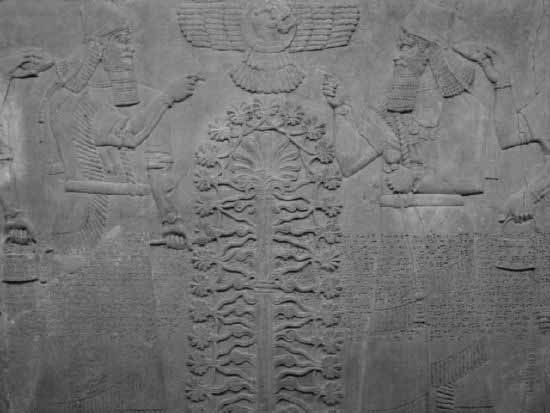
Sumerian Gods (Anunnaki) Create the Human Race
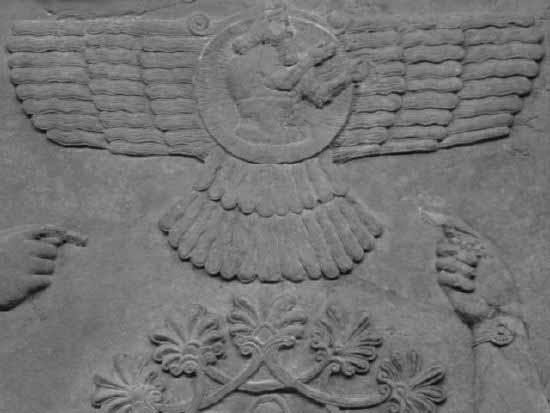
Sumerian god Anu is depicted much like the Faravahar
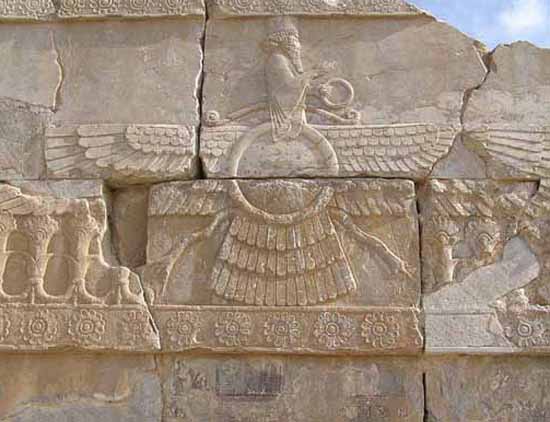
According to Ancient Alien Theory
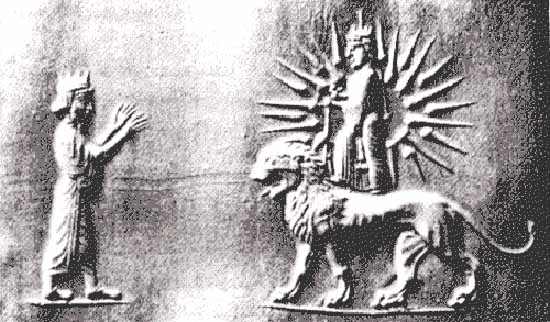
Ahura Madza (Faravahar) was an alien protector of Earth
His symbols include the lion, wings, flame, and crown.
According to Zoroastrian belief, when Zoroaster was 30 years old, he went into the Daiti river to draw water for a Haoma ceremony; when he emerged, he received a vision of Vohu Manah. After this, Vohu Manah took him to the other six Amesha Spentas, where he received the completion of his vision.
This vision radically transformed his view of the world, and he tried to teach this view to others. Zoroaster believed in one creator God, teaching that only one God was worthy of worship. Furthermore, some of the deities of the old religion, the Daevas (Devas in Sanskrit), appeared to delight in war and strife. Zoroaster said that these were evil spirits and were workers of Angra Mainyu, God's adversary.
Zoroaster's ideas did not take off quickly, and, at first, he only had one convert: his cousin Maidhyoimanha. The local religious authorities opposed his ideas. They felt their own faiths, power, and particularly their rituals, were threatened because Zoroaster taught against over-ritualising religious ceremonies. Many ordinary people did not like Zoroaster's downgrading of the Daevas to evil spirits. After 12 years, Zoroaster left his home to find somewhere more open to new ideas.
He found such a place in the country of King Vishtaspa (in Bactria). The King and his queen, Hutosa, heard Zoroaster debating with the religious leaders of his land, and decided to accept Zoroaster's ideas and make them the official religion of their kingdom. Zoroaster died in his late 70s. Very little is known of the time between Zoroaster and the Achaemenian period, except that, during this period, Zoroastrianism spread to Western Iran. By the time of the founding of the Achaemenid Empire, Zoroastrianism was already a well-established religion.
In Zoroastrianism, Ahura Mazda is the beginning and the end, the creator of everything that can and cannot be seen, the Eternal, the Pure and the only Truth. In the Gathas, the most sacred texts of Zoroastrianism thought to have been composed by Zoroaster himself, the prophet acknowledged devotion to no other divinity besides Ahura Mazda.
Daena (din in modern Persian) is the eternal Law, whose order was revealed to humanity through the Mathra-Spenta ("Holy Words"). Daena has been used to mean religion, faith, law, and even as a translation for the Hindu and Buddhist term Dharma. The latter is often interpreted as "duty" but can also mean social order, right conduct, or virtue. The metaphor of the "path" of Daena is represented in Zoroastrianism by the muslin undershirt Sudra, the "Good/Holy Path", and the 72-thread Kushti girdle, the "Pathfinder".
Daena should not be confused with the fundamental principle asha (Vedic rta), the equitable law of the universe, which governed the life of the ancient Indo-Iranians. For these, asha was the course of everything observable - the motion of the planets and astral bodies; the progression of the seasons; and the pattern of daily nomadic herdsman life, governed by regular metronomic events such as sunrise and sunset.
All physical creation (geti) was thus determined to run according to a master plan - inherent to Ahura Mazda - and violations of the order (druj) were violations against creation, and thus violations against Ahura Mazda. This concept of asha versus the druj should not be confused with the good-versus-evil battle evident in western religions, for although both forms of opposition express moral conflict, the asha versus druj concept is more systemic and less personal, representing, for instance, chaos (that opposes order); or "uncreation", evident as natural decay (that opposes creation); or more simply "the lie" (that opposes truth and righteousness). Moreover, in his role as the one uncreated creator of all, Ahura Mazda is not the creator of druj, which is "nothing", anti-creation, and thus (likewise) uncreated. Thus, in Zoroaster's revelation, Ahura Mazda was perceived to be the creator of only the good (Yasna 31.4), the "supreme benevolent providence" (Yasna 43.11), that will ultimately triumph (Yasna 48.1).
In this schema of asha versus druj, mortal beings (both humans and animals) play a critical role, for they too are created. Here, in their lives, they are active participants in the conflict, and it is their duty to defend order, which would decay without counteraction. Throughout the Gathas, Zoroaster emphasizes deeds and actions, and accordingly asceticism is frowned upon in Zoroastrianism. In later Zoroastrianism, this was explained as fleeing from the experiences of life, which was the very purpose that the urvan (most commonly translated as the "soul") was sent into the mortal world to collect. The avoidance of any aspect of life, which includes the avoidance of the pleasures of life, is a shirking of the responsibility and duty to oneself, one's urvan, and one's family and social obligations.
Central to Zoroastrianism is the emphasis on moral choice, to choose the responsibility and duty for which one is in the mortal world, or to give up this duty and so facilitate the work of druj. Similarly, predestination is rejected in Zoroastrian teaching. Humans bear responsibility for all situations they are in, and in the way they act toward one another. Reward, punishment, happiness, and grief all depend on how individuals live their lives.
In Zoroastrianism, good transpires for those who do righteous deeds. Those who do evil have themselves to blame for their ruin. Zoroastrian morality is then to be summed up in the simple phrase, "good thoughts, good words, good deeds" (Humata, Hukhta, Hvarshta in Avestan), for it is through these that asha is maintained and druj is kept in check. Through accumulation, several other beliefs were introduced to the religion that, in some instances, supersede those expressed in the Gathas. In the late 19th century, the moral and immoral forces came to be represented by Spenta Mainyu and its antithesis Angra Mainyu, the "good spirit" and "evil spirit" emanations of Ahura Mazda, respectively.
Although the names are old, this opposition is a modern Western-influenced development popularized by Martin Haug in the 1880s, and was, in effect, a realignment of the precepts of Zurvanism (Zurvanite Zoroastrianism), which had invented a third deity, Zurvan, to explain a mention of twinship (Yasna 30.3) between the moral and immoral. Although Zurvanism had died out by the 10th century, the critical question of the "twin brothers" mentioned in Yasna 30.3 remained, and Haug's explanation provided a convenient defence against Christian missionaries, who disparaged the Parsis for their "dualism". Haug's concept was subsequently disseminated as a Parsi interpretation, thus corroborating Haug's theory, and the idea became so popular that it is now almost universally accepted as doctrine.
Achaemenid era (648–330 BCE) Zoroastrianism developed the abstract concepts of heaven and hell, as well as personal and final judgment, all of which are only alluded to in the Gathas. Yasna 19 (which has only survived in a Sassanid era ([-650 CE] Zend commentary on the Ahuna Vairya invocation), prescribes a Path to Judgment known as the Chinvat Peretum or Chinvat bridge (cf: As-Sirat in Islam), which all souls had to cross, and judgment (over thoughts, words, and deeds performed during a lifetime) was passed as they were doing so. However, the Zoroastrian personal judgment is not final. At the end of time, when evil is finally defeated, all souls will be ultimately reunited with their Fravashi. Thus, Zoroastrianism can be said to be a universalist religion with respect to salvation.
In addition, and strongly influenced by Babylonian and Akkadian practices, the Achaemenids popularized shrines and temples, hitherto alien forms of worship. In the wake of Achaemenid expansion, shrines were constructed throughout the empire and particularly influenced the role of Mithra, Aredvi Sura Anahita, Verethregna and Tishtrya, all of which, in addition to their original (proto-)Indo-Iranian functions, now also received Perso-Babylonian functions.
According to the Zoroastrian story of creation, Ahura Mazda existed in light in goodness above, while Angra Mainyu existed in darkness and ignorance below. They have existed independently of each other for all time, and manifest contrary substances.
Ahura Mazda first created seven abstract heavenly beings called Amesha Spentas, who support him and represent beneficent aspects, along with numerous yazads, lesser beings worthy of worship. He then created the universe itself in order to ensnare evil. Ahura Mazda created the floating, egg-shaped universe in two parts: first the spiritual (menog) and 3,000 years later, the physical (getig). Ahura Mazda then created Gayomard, the archetypical perfect man, and the first bull.
While Ahura Mazda created the universe and mankind, Angra Mainyu, whose instinct is to destroy, created demons, evil yazads, and noxious creatures (khrafstar) such as snakes, ants, and flies. Angra Mainyu created an opposite, evil being for each good being, except for humans, which he found he could not match. Angra Mainyu invaded the universe through the base of the sky, inflicting Gayomard and the bull with suffering and death. However, the evil forces were trapped in the universe and could not retreat.
The dying primordial man and bull emitted seeds. From the bull's seed grew all beneficial plants and animals of the world, and from the man's seed grew a plant whose leaves became the first human couple. Man thus struggles in a two-fold universe trapped with evil. The evils of this physical world are not products of an inherent weakness, but are the fault of Angra Mainyu's assault on creation. This assault turned the perfectly flat, peaceful, and ever day-lit world into a mountainous, violent place that is half night.
Zoroastrianism also includes beliefs about the renovation of the world and individual judgment (cf. general and particular judgment), including the resurrection of the dead.
Individual judgment at death is by the Bridge of Judgment, which each human must cross, facing a spiritual judgment. Humans' actions under their free will determine the outcome. One is either greeted at the bridge by a beautiful, sweet-smelling maiden or by an ugly, foul-smelling old woman. The maiden leads the dead safely across the bridge to the Amesha Spenta Good Mind, who carries the dead to paradise. The old woman leads the dead down a bridge that narrows until the departed falls off into the abyss of hell.
Zoroastrian hell is reformative; punishments fit the crimes, and souls do not rest in eternal damnation. Hell contains foul smells and evil food, and souls are packed tightly together although they believe they are in total isolation.
In Zoroastrian eschatology, a 3,000-year struggle between good and evil will be fought, punctuated by evil's final assault at which time the sun and moon will darken and mankind will lose its reverence for religion, family, and elders. The world will fall into winter, and Angra Mainyu's most fearsome miscreant, Azi Dahaka, will break free and terrorize the world.
The final savior of the world, Saoshyant, will be born to a virgin impregnated by the seed of Zoroaster while bathing in a lake. Saoshyant will raise the dead - including those in both heaven and hell - for final judgment, returning the wicked to hell to be purged of bodily sin.
Next, all will wade through a river of molten metal in which the righteous will not burn. Heavenly forces will ultimately triumph over evil, rendering it forever impotent. Saoshyant and Ahura Mazda will offer a bull as a final sacrifice for all time, and all men will become immortal. Mountains will again flatten and valleys will rise; heaven will descend to the moon, and the earth will rise to meet them both. Man requires two judgments because there are as many aspects to his being: spiritual (menog) and physical (getig).